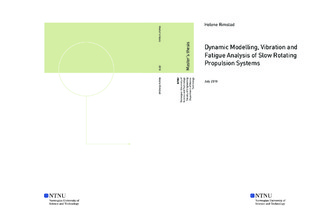| dc.description.abstract | In recent years, shipping has experienced a technical transformation motivated by its impact on the environment and the desire to reduce operational costs. Engines with lower power ranges and slow steaming are two examples. These modifications have fulfilled their purpose, but there are also downsides such as increased torsional vibrations. This master thesis presents an approach to the issue. A case study, the drive train of a modern eco-ship, is used for this purpose. It is driven directly by a two-stroke diesel engine, with a torsional vibration damper (TVD) mounted on its free end, and the propeller is fixed pitch. System characteristics are provided by DNV GL. The presented method is general, and can be applied on other propulsion systems as well. The final goal is to identify vibration reduction measures and to evaluate the consequences of severe torsional vibrations.
All vibration analyzes need a steady foundation in terms of an accurate software model. The applied mathematical approach is the one degree of freedom lumped mass method. Masses are modelled as rigid and shafts are massless. Damping is further introduced through the dynamic magnifier model, defining damping as independent of varying rotational speed. Nauticus Torsional Vibration, a software from DNV GL, is used to simulate in frequency domain. Simpack Multi-Body Simulation Software is utilized to introduce the aspect of time. Two software models are thereby constructed, both from the lumped mass model of the drive train. The model in Nauticus Machinery is verified by empirical data from DNV GL. Time limitations resulted in absent propeller damping in Simpack, in addition to a simplified engine torque. Only the system's free and undamped behavior is therefore reconstructed in this software.
Free and forced vibration analyzes are performed in both softwares, aiming at identifying critical speeds and vulnerable shaft segments. Further analyzes focus on these frequencies and parts. Calculations of natural frequencies and construction of Campbell diagrams detect critical excitations. Power spectra, evaluating energy levels by use of the WAFO MATLAB toolbox, are used to validate these speeds. The most dangerous resonance speed was found to be 45 rpm. Mode shapes are used to identify stationary points vulnerable towards torsional fracture. Additionally, resulting torque and torsional stress amplitudes help locate critical shaft segments. Five specific shafts were then revealed; the one connecting the damper to the engine, two segments of the crank shaft, the intermediate shaft and the propeller shaft.
%From Amir
%Torsional vibrations are not only dangerous because they initiate high peak displacements (ultimate limit state) that could result in fracture, they also increase the risk of fatigue failure especially if the system operates in such conditions more often.
Torsional vibrations are not only dangerous because they initiate high peak displacements (ultimate limit state) that could result in fracture, they also increase the risk of fatigue failure especially if the system is subjected to large vibrations loads more often. Calculations of fatigue damage (also by use of WAFO), which requires time domain simulation, are therefore also included in this research. Since forced vibration analysis results from Simpack are not verified, these studies can only indicate triggers of fatigue, not evaluate if failure will occur in the drive train or not. However, they present a general procedure of how to calculate fatigue damage. Both operation at 45 rpm and the MCR condition were evaluated, in addition to elaborate analyzes of the five mentioned shafts. Vibrations with large amplitudes, occurring over long periods, were identified as a source of fatigue. Furthermore, it was observed that shaft dimensions significantly influenced fatigue. A higher level of radius divided by second area moment results in an increased risk of failure.
Vibration reduction is investigated in terms of a sensitivity analysis in Nauticus Machinery, performed by modifying shaft stiffness and damping factors. Decreased levels of torque and torsional stress, in the identified critical segments at resonance speed, is the general indication of reduced vibrations. Introduction of damping in the intermediate shaft was the most effective modification. By replacing the intermediate shaft with a shaft that has the same properties as the TVD, torque and stress amplitudes were reduced with 70% in shafts after the engine. Unfortunately, a practical solution to implement this change was not found. An increase of hydrodynamic damping, which could be achieved by a controllable pitch propeller, decreased the vibration responses with 30%. Increasing stiffness and adding mass damping in the TVD, which could be obtained by choosing a different design, reduced the levels with about 5%. At last, the thesis addresses that operational profiles also influence damage levels from vibrations.
The author presents and is aware of the major assumptions and simplifications in her work. Introduction of damping through the dynamic magnifier model is one example, and mathematical modelling by the lumped mass approach is another. Nevertheless, the objectives are obtained and all analyzes are presented in such a way that they can be reconstructed by others in the future. Established theory and methods are taken into account throughout the work. | |

